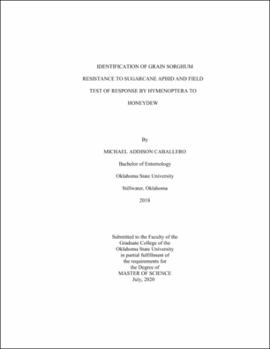| dc.description.abstract | Grain sorghum, Sorghum bicolor, is one of the most important crops worldwide as it can be used for human consumption, biofuel, and livestock feed. In 2013, the sugarcane aphid, Melanaphis sacchari (SCA), switched host plants from their primary host, sugarcane, to sorghum, and caused substantial losses in sorghum yield. It overwinters on Johnsongrass. Sorghum halepense, and sorghum in south Texas and Mexico and has become a perineal pest. When the aphid feeds, it damages plant tissue stunting the plant, causing chlorosis, and reducing yield. SCA colonies quickly multiply and produce large amounts of sugary excretia called honeydew. Plant tolerance is an important tool for managing pest populations and a series of greenhouse trials were conducted to assess sorghum germplasm for resistance to SCA. This study tested 19 new germplasm against 1 resistant and 3 susceptible checks. The plants were evaluated for plant damage (1-9), chlorophyll content, height, and leaf number. The resistance trials discovered 11 new germplasm, which displayed resistance similar to the known resistant with two performing better than the known check. In the field, many Hymenoptera were observed visiting SCA honeydew. A series of field collections in sorghum and Johnsongrass were made to test if SCA honeydew influenced Hymenoptera diversity and abundance. Pan traps (yellow, blue, and white), and yellow sticky traps were used to collect Hymenoptera. A total of 3,950 individuals were collected with 30 families, 124 morphospecies, and 2,384 individuals from sorghum and 29 families, 121 morphospecies, and 1,566 individuals from Johnsongrass. The presence of aphids increased capture rates of the families: Halictidae, Sphecidae, Brachonidae, Encyrtidae, Mymaridae, Diapriidae, Scelionidae, and Formicidae. The Johnsongrass surveys were disrupted by mowing; however, the data were similar to sorghum trials. The results of these experiments show germplasm to combat the SCA is available and that SCA may have a positive influence on native Hymenoptera species by generating a sugar resource. These findings provide the potential for growers to place borders of susceptible sorghum around resistant cultivars to benefit insect diversity and abundance while maintaining yield. | |
